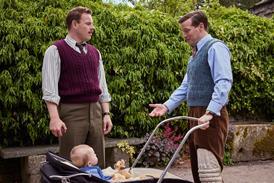Filming wildebeest should, in theory, be easier than filming lions, elephants or bears, the previous subjects of the Spy in the -series. After all, they aren't dangerous, they are less likely to trash remote cameras and there are 1.5 million of them. However, they are among the most nervous creatures on earth; being on the menu of just about every African animal with teeth and claws would give anyone a persecution complex. This nervousness was to prove our greatest challenge.
The great wildebeest migration is one of the wonders of the natural world; a year-long odyssey that takes this mega-herd on a circular journey across the plains of Tanzania, up north into Kenya's Masai Mara and back again. The journey is driven by the seasonal pattern of the rains and ensures that the wildebeest can fully exploit any fresh pasture. On the way they encounter great physical challenges and numerous predators. These moments of high drama draw wildlife film-makers to the subject time and again. My aim was to film them closer than they had ever been filmed before.
The remote cameras used in our previous productions provided a ready-made arsenal for this fresh perspective. These radio-controlled and camouflaged spycams carry a camera into the heart of any animal action. Pictures are relayed back to a filming vehicle where camera functions such as zoom and focus are also controlled. The spycams are engineered by Geoff Bell, a radio-modelling genius, who also controls and maintains the devices in the field. He works in close partnership with Michael Richards, one of the world's greatest wildlife cameramen, who is ultimately responsible for the images captured. Both are aided by David Breed as spotter/cameraman and Phillip Dalton, the producer in the field.
Of all the spycams we had previously used, bouldercam (a remote-controlled model rock) had proved the most versatile. It had already survived encounters with lions, bears, pandas and elephants. It was the obvious choice for our first tests to film wildebeest.
The first shoot was on the plains of the Serengeti where, in a baby boom lasting just three weeks, half a million wildebeest are born. The early tests weren't promising; as soon as bouldercam was deployed, several thousand eyes followed it wherever it went. Dungcam was next off the mark - this remote spycam, based on a pile of elephant dung, fared better but still struggled to bridge the gap between subject and camera and capture 'in your face' images.
The breakthrough came when we realised that the wildebeest reacted to any raised landscape feature as if it was a stalking lion. Rather than conceal our spycams we decided we had to be bolder with our designs. What we needed were instantly recognisable concepts that couldn't be mistaken for predators. Enter tortoisecam - a caterpillar-tracked, slow-moving, camera-carrying replica of a real tortoise. This was joined by other static devices such as skullcam, hippocam and treecam. Soon we were getting results.
The same conspicuous but non-threatening concept had to be applied to our aerial devices too. Dragonflycam, a tiny flying device that could film just a few feet above the wildebeest without causing alarm, was the result of a similar makeover. In the water, croccam and hippocam were soon bringing back pictures too. Gradually we developed nearly 20 different cameras. Around half were fully mobile, while the static ones were triggered by approaching animals.
As the footage accumulated, keeping the equipment serviceable became the greatest challenge. A hyena carried off one skullcam, and three others vanished when rainfall caused the river to flood unexpectedly. The same raging river nearly claimed the croccam too - but not before it had taken some of the most valuable footage of the series, filming the herd's struggle with the river in full flood. It's one my personal highlights of the film.
Dragonflycam, after gamely capturing remarkable close proximity aerial shots, suffered a worse fate; it inexplicably lost radio contact capturing astonishing video of the surprised herds as it nose-dived into the ground.
The crew had other excitements too. One night a pack of hyenas chased a calf into the mess tent and decided, rather appropriately, that this was a great place for a meal.
Another time, as Mike positioned spycams on the riverbank, a charging buffalo appeared from nowhere. While Mike dodged, the buffalo swerved towards Geoff, attending dragonflycam by the filming vehicle. Mike shouted a warning and Geoff rocketed into the vehicle as the buffalo hit. The impact nearly overturned the vehicle - but no one was harmed. Luckily, the buffalo decided to retreat.
Fortunately, such mishaps were few and far between and, over the course of the three-year production, the spycams, supplemented with vehicle-mounted cameras, captured around 500 hours of footage. Editing this into a coherent story that followed a calf's journey became the next great challenge.
Trek - Spy on the Wildebeest airs on BBC1 on Sunday 14 January at 8pm and on 21 January at 7pm

























No comments yet